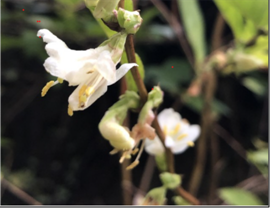February 2022
1. What is going on in the hive?
By now, your bees will be calculating when they need new bees to replace the overwintering bees that will die out — so they will be feeding your queen to encourage her to lay, planning around 6 weeks ahead, bearing in mind that typically a worker bee takes 21 days to emerge, and will be busy with housework and guarding duties for a further 21 days until she turns to foraging duties. So an egg laid now will become a useful forager in 6 weeks’ time when it will be mid March and spring will hopefully be springing.
With this in mind, the queen will start laying if she hasn’t already, so there will be an increased need for warmth in the hive, and extra mouths to feed, at the same time as a falling off of foraging bees as the old bees die out, and some chilly weather.
The weather has been up and down over the past few months, freezing one day and 12 degrees the next. My bees have been flying when it has been warm enough — using up energy to search for scant sources of nectar and pollen at this time of year.
This all puts pressure on the stores in the hive, so make sure your bees have plenty of food — add some fondant if you are unsure, and keep an eye on it, getting ready to top that up if necessary.
2. Check your hives
It is much too early to do a full inspection of your hives but on a warm day (above 10°C) make a point of watching the entrance of your hives. Is there activity, and what are the bees doing? Are they bringing in pollen? The bees are likely to be doing cleansing flights, so don’t hang your washing out nearby!
Make sure that the entrance to the hive is not blocked with dead bees. Undertaker bees can have difficulty getting dead bees out when a mouseguard is in place, so make sure there is no build up behind the mouseguard.
We could still have snow, so ensure that snow is not blocking the entrance.
If you are unlucky enough to find a colony that has died out, seal the hive immediately to prevent other colonies from robbing it out, spreading any diseases that may have caused their demise. Make a plan to do the sad job of a post mortem and clear out of that hive before spring.
3. Get ready for silly season
It’s time to get all the kit out of the bee shed and see what you are missing for the season ahead. You will need frames made up with fresh foundation, spare hives or nuc’s at the ready. So this is just an audit at this stage, but make a plan to get things ready to go, you will be glad you did!
4. Check the larder
I had a wander round my garden this week to see what forage is around for my bees. Catkins, a few snowdrops, witchhazel, winter flowering honeysuckle and viburnum tinus. What could you add to your garden that would help your bees this time next year? Mahonia is on my wish list.




Photos (c) Janine Sparks
5. Improve your knowledge
The BBKA Spring convention is from 8th to 10th April at Harper Adams University in Shropshire, and tickets have just gone on sale. I go every year, and always come away buzzing (sorry) with the knowledge I have gained from the various workshops and seminars. Whilst the content is mostly about honeybees, other subjects are also covered, such as the Asian Hornet, Bumble bees, Hedge laying, and trailer reversing … something for everyone! There is also a brilliant trade show on the Saturday when you can spend a fortune on bee equipment often at special show prices. Take a look at the programme here: https://www.bbka.org.uk/bbka-spring-convention-2022
BBKA module examinations are looming … why not think about studying for one of the modules? The next exam date is 19th March 2022 and your application must be received by 7th February. If that is too soon, then November is the next exam date. I think the modules that I have taken make me a better beekeeper! See Exams and Assessments of the BBKA (British Beekeepers Association).
